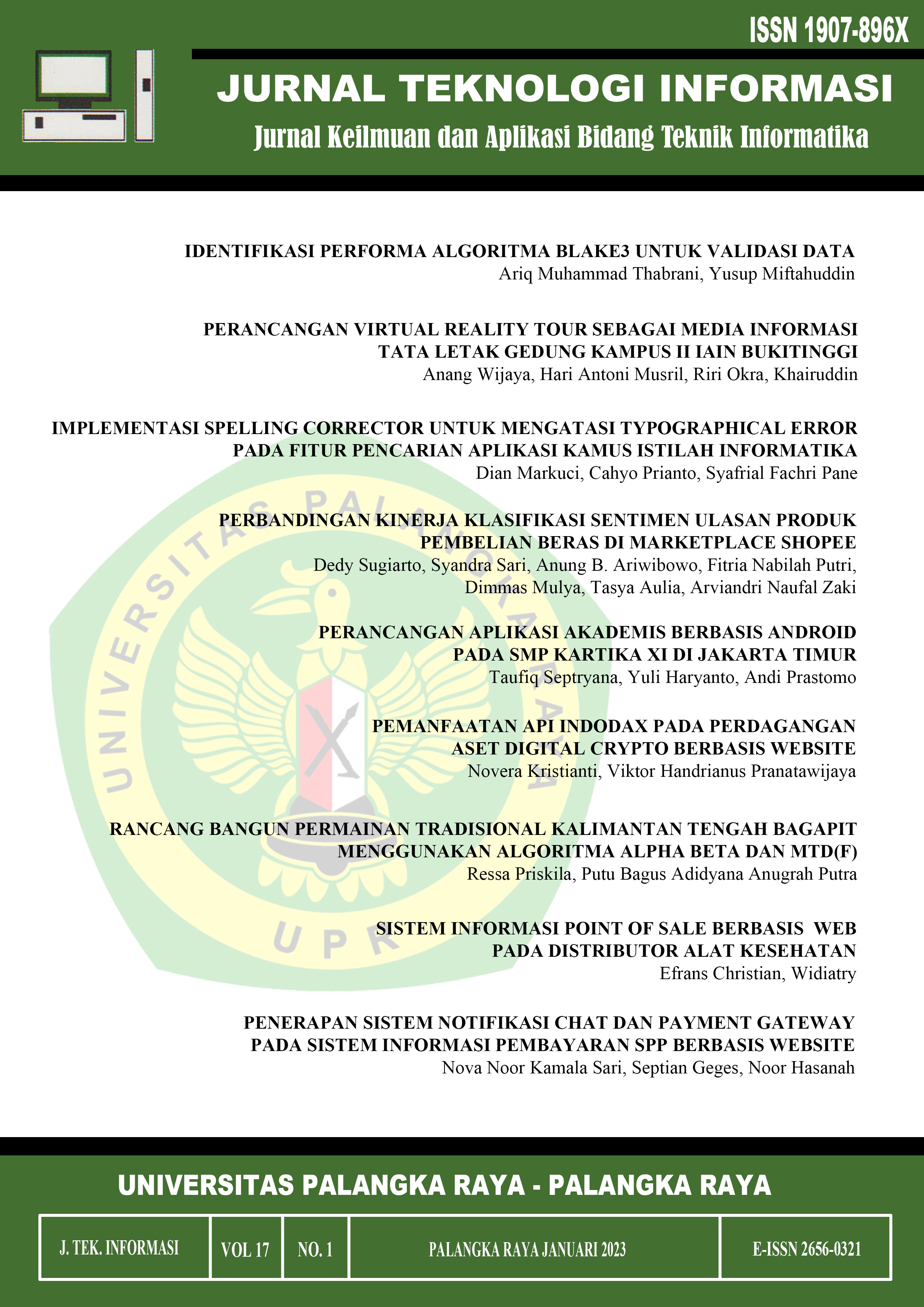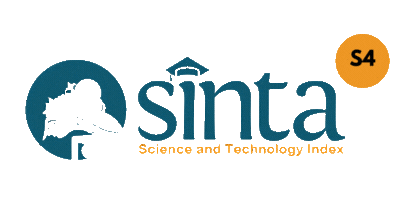IMPLEMENTASI SPELLING CORRECTOR UNTUK MENGATASI TYPOGRAPHICAL ERROR PADA FITUR PENCARIAN APLIKASI KAMUS ISTILAH INFORMATIKA
DOI:
https://doi.org/10.47111/jti.v17i1.5520Keywords:
Search, Spelling Corrector, Flask, Probability, DictionaryAbstract
Information needs can arise because of a knowledge gap in a person with the necessary information needs, one of which is knowledge in the field of computers and informatics, especially related to terms in the computer field. Therefore we need a system that makes it easy for users to meet the information needs needed by building a digital dictionary application related to computer terms and informatics by utilizing the search engine features in it. Search activities are carried out daily to meet information needs. However, an error that is often unavoidable in performing a search is a typing error in the query. As a result, the information sought is not as expected. Based on this, we need a system that can identify typographical errors in the search text. So in this research, a website-based dictionary of computer and informatics terms will be developed by applying Peter Norvig's spelling corrector using the Python language with the flask framework. The implementation results show that Peter Norvig's spelling corrector method can be applied to computer and informatics term dictionary applications. This can be seen at the level of accuracy reaching 89% in correcting 180 word variations that contain typographical errors based on the highest probability of each possible word in the corpus. However, there is a lack of this spelling corrector method, it is still difficult to overcome typos in spelling abbreviations and typographical errors that exceed 1 letter
Downloads
References
R. Rismayani, N. Sambo Layuk, S. Wahyuni, H. Wali, and N. K. Marselina, “Pencarian Kata Pada Aplikasi Kamus Istilah Komputer dan Informatika Menggunakan Algoritma Brute Force Berbasis Android,” Komputika J. Sist. Komput., vol. 10, no. 1, pp. 43–52, 2021, doi: 10.34010/komputika.v10i1.3644.
N. K. Tran, Q. Z. Sheng, M. Ali Babar, L. Yao, W. E. Zhang, and S. Dustdar, “Internet of things search engine,” Commun. ACM, vol. 62, no. 7, pp. 66–73, 2019, doi: 10.1145/3284763.
A. I. Fahma, I. Cholissodin, and R. S. Perdana, “Identifikasi Kesalahan Penulisan Kata (Typographical Error) Pada Dokumen Berbahasa Indonesia Menggunakan Metode N-Gram Dan Levenshtein Distance,” J. Pengemb. Teknol. Inf. dan Ilmu Komput., vol. 2, no. 1, pp. 53–62, 2018.
D. Hládek, J. Staš, and M. Pleva, “Survey of automatic spelling correction,” Electron., vol. 9, no. 10, pp. 1–29, 2020, doi: 10.3390/electronics9101670.
R. Martin, D. S. Naga, and V. C. Mawardi, “Penggunaan Spelling Correction Dengan Metode Peter Norvig Dan N-Gram,” J. Ilmu Komput. dan Sist. Inf., vol. 9, no. 1, p. 175, 2021, doi: 10.24912/jiksi.v9i1.11591.
Mutammimah, H. Sujaini, and R. D. Nyoto, “Peter Norvig dan Spelling Checker BK-Trees pada Kata Berbahasa Indonesia,” J. Sist. dan Teknol. Inf., vol. 5, no. 1, pp. 1–5, 2016.
T. M. Fahrudin, I. Sa’diyah, L. Latipah, I. Z. Atha Illah, C. C. Bey Lirna, and B. S. Acarya, “Aplikasi Pendeteksi Kesalahan Ejaan Bahasa Indonesia Pada Karya Ilmiah Bidang Ilmu Komputer Menggunakan Kebi 1.0 Checker,” Pros. Semin. Nas. Inform. Bela Negara, vol. 2, pp. 64–72, 2021, doi: 10.33005/santika.v2i0.104.
R. Alfred and R. W. Teoh, Improving topical social media sentiment analysis by correcting unknown words automatically, vol. 937. Springer Singapore, 2019.
R. Irsyad, “Penggunaan Python Web Framework Flask Untuk Pemula,” Lab. Telemat. Sekol. Tek. Elektro Inform., pp. 1–4, 2018.
D. Ghimire, “Comparative study on Python web frameworks: Flask and Django,” no. May, pp. 1–40, 2020, [Online]. Available: http://www.theseus.fi/handle/10024/339796.
M. Dr. Umar Sidiq, M.Ag Dr. Moh. Miftachul Choiri, Metode Penelitian Kualitatif di Bidang Pendidikan, vol. 53, no. 9. 2019.
A. Rijali, “Analisis Data Kualitatif,” Alhadharah J. Ilmu Dakwah, vol. 17, no. 33, p. 81, 2019, doi: 10.18592/alhadharah.v17i33.2374.
N. M. A. J. Astari, Dewa Gede Hendra Divayana, and Gede Indrawan, “Analisis Sentimen Dokumen Twitter Mengenai Dampak Virus Corona Menggunakan Metode Naive Bayes Classifier,” J. Sist. dan Inform., vol. 15, no. 1, pp. 27–29, 2020, doi: 10.30864/jsi.v15i1.332.
U. Chuzaimah Zulkifli, “Pengembangan Modul PreprocessingTeks untuk Kasus Formalisasi dan Pengecekan Ejaan Bahasa Indonesia pada Aplikasi Web Mining Simple Solution (WMSS),” J. Mat. Stat. dan Komputasi, vol. 15, no. 2, p. 95, 2018, doi: 10.20956/jmsk.v15i2.5718.
T. M. Fahrudin, I. Sa’diyah, Latipah, I. Z. Atha Illah, C. C. Beylirna, and B. S. Acarya, “Analysis and Development of KEBI 1.0 Checker Framework as an Application of Indonesian Spelling Error Detection,” Int. J. Data Sci. Eng. Anaylitics, vol. 1, no. 2, pp. 12–26, 2021, doi: 10.33005/ijdasea.v1i2.9.
P. Norvig, “How to Write a Spelling Corrector,” 2007. https://norvig.com/spell-correct.html.
T. Shooting, D. Metode, and S. Pakar, “JURNAL CAHAYA BAGASKARA Vol. 6. No. 1 - Februari 2021,” vol. 6, no. 1, 2021.
M. N. Cholis, E. Yudaningtyas, and M. Aswin, “Pengaruh Penggunaan Synonym Recognition dan Spelling Correction pada Hasil Aplikasi Penilaian Esai dengan Metode Longest Common Subsequence dan Cosine Similarity,” InfoTekJar (Jurnal Nas. Inform. dan Teknol. Jaringan), vol. 3, no. 2, pp. 138–142, 2019, doi: 10.30743/infotekjar.v3i2.1061.
P. Norvig, “technical papers, essays, reports, software, and other materials by Peter Norvig.” https://norvig.com/












